The Legend of Zelda: Link's Awakening $59.99
Stuck between an egg and a hard place.
The Legend of Zelda series rates amongst my favorites in all of games. The worlds are beautiful, weird, and full of surprises. So, naturally, I was excited for the announcement and release of Link’s Awakening, a game which first released just over a month before I was born. After playing it, I’m starting to think that Link’s Awakening would have been better left in the past, recounted only in stories of how weird it is.
From the moment the game started, I was filled with disappointment as the beautiful animation depicting the storm that brings Link to Koholint island gives way to a knock-off Funko Pop style. The opening cinematic is reminiscent of the old art found in manuals for the early games in the series. The art that makes up the game is mostly good, great even, but I despise the design they used for Link. His beady, dead eyes and round head just make me upset every time I look at them. The other inhabitants and monsters of the island cause me no such distress. Maybe the reason Link needs to awaken is that he’s been transformed into a horrible nightmare creature unfit for human contact.
As you wake up in the home of Marin and Tarin, the father and daughter duo who saved you from your 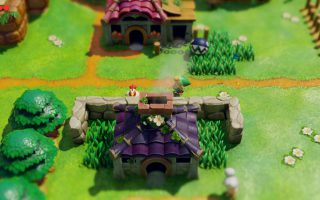 shipwreck, the oddness of the island immediately jumps out at you – both figuratively and literally – as a Chain Chomp barks and lunges towards you. You’re in no danger though, this Chain Chomp just has no other way to interact with the world – At least while he’s chained up at home. On a Gameboy in 1993, I can totally see how this would be surreal and unexpected. But in a world where I can boot up my Switch at any time and see three different versions of Link fight Solid Snake in Dracula’s Castle, seeing a Chain Chomp or Goomba in a Zelda game doesn’t feel like it lives up to the reputation of the wacky and wild Nintendo of today.
shipwreck, the oddness of the island immediately jumps out at you – both figuratively and literally – as a Chain Chomp barks and lunges towards you. You’re in no danger though, this Chain Chomp just has no other way to interact with the world – At least while he’s chained up at home. On a Gameboy in 1993, I can totally see how this would be surreal and unexpected. But in a world where I can boot up my Switch at any time and see three different versions of Link fight Solid Snake in Dracula’s Castle, seeing a Chain Chomp or Goomba in a Zelda game doesn’t feel like it lives up to the reputation of the wacky and wild Nintendo of today.
Perhaps if the game did more to subvert the traditional mechanics players have come to expect in a Zelda game it would still hold some of that mystery and intrigue (Breath of the Wild notwithstanding). Instead, you get a fairly standard top-down Zelda game, with only a few alterations ( that detract from the experience more than they add). Having never played the original release on Gameboy, I can’t speak to the changes that the 2019 remake has implemented compared to the original version, but I can say that there are numerous ideas implemented that just aren’t great today.
One of those ideas is that you can only have two items equipped at a time. I’ve mostly played 3D Zelda games, where you can equip up to three items at any time. Having a mere two feels like playing with an arm tied behind your back, but every ten seconds you need to take a break to change which limb is restrained. One of the main reasons this feels so egregious is Roc’s Feather, an item which allows Link to leap into the 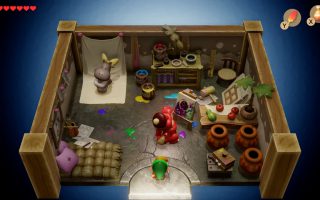 air and cross holes and chasms and leap over enemies to gain the upper hand in combat. This feels fresh in this style of Zelda game – at least based on the ones I’ve played – but it also felt like I needed it equipped for 90% of the game. That meant I had basically one slot that I could change items in and out of while still feeling effective. Compare this to the Pegasus Boots, which have TWO (2) whole shoulder buttons dedicated to them. There is no reason that Roc’s Feather couldn’t have also been assigned to one of the L or R buttons, which would save tons of time in menus. Hell, there is a whole D-pad that sits unused which could have had a quick swap for items mapped to it. There are only a handful of items peppered throughout the game in the game, and many you can easily pass over.
air and cross holes and chasms and leap over enemies to gain the upper hand in combat. This feels fresh in this style of Zelda game – at least based on the ones I’ve played – but it also felt like I needed it equipped for 90% of the game. That meant I had basically one slot that I could change items in and out of while still feeling effective. Compare this to the Pegasus Boots, which have TWO (2) whole shoulder buttons dedicated to them. There is no reason that Roc’s Feather couldn’t have also been assigned to one of the L or R buttons, which would save tons of time in menus. Hell, there is a whole D-pad that sits unused which could have had a quick swap for items mapped to it. There are only a handful of items peppered throughout the game in the game, and many you can easily pass over.
In fact, you can pass over a lot in this game because it isn’t interested in holding your hand or giving you detailed explanations of much of anything. You can miss whole mechanics and items for most of the game only to realize in the final leg of the game that you don’t have the tools needed to progress or the game just takes a lot longer to complete because you didn’t happen to go in a certain cave that you were never directed towards. The game is by no means short, but it feels shallow compared to other games in the series. Many of the items you find in the game have a super-limited use case and some will see their usefulness depleted after about 10 minutes. I’m looking at you, Fire Rod. If the island were worth exploring, I might feel 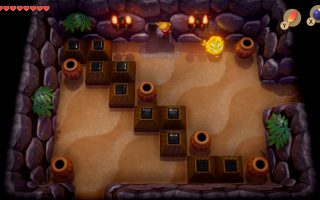 differently, but there are only so many block-pushing puzzles a person can feel compelled to do.
differently, but there are only so many block-pushing puzzles a person can feel compelled to do.
The game doesn’t wholly leave the player to fend for themselves, as you can call old man Ulrira who will give you vague guidance on where you should be going next. He won’t tell you what you need to do to do prepare yourself for the location he guides you towards, so you end up sort of lost, you know your destination but lack the means to enter upon arrival.
With all of the negatives I’ve listed about the game, you may be wondering, “doesn’t he like anything about this game?” Of course, the Zelda series comes with a sort of baseline quality that is hard to deny. Exploring is fun, to a point, and as previously mentioned, the aesthetic is cute (even if Link is awful), and the music is good, which feels redundant to say. The Zelda series is synonymous with amazing music. But it doesn’t stand out here.
The combat is decently fun, if not a little simple. Completing the color dungeon about a third of the way through the game allows you to choose a new tunic that will trivialize most of the combat throughout the rest of the game. The jump ability gives new options for finding vulnerable spots on foes, or just avoiding them completely.
Unfortunately, that’s about where all my praise for the game ends. While the world looks and sounds nice, it feels overly padded with obstacles to make traversing a chore. Especially so if you miss the warp song.
Once you get into the dungeons, things aren’t much better. I attribute a sense of interconnectedness to dungeons in the Zelda series. If you follow a path for long enough, it will eventually spit you out in a familiar 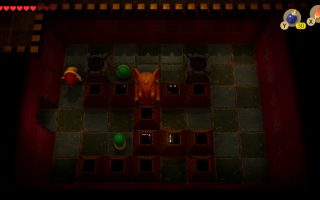 area, from which you’ll again branch off into a new section of the dungeon. Link’s Awakening, instead, feels like the dungeons lack the cohesion that makes me appreciate the other games in the series so much. Paths through the dungeons often end in dead ends, which means you’ll need to slowly wander back across the dungeon to use whatever item or key you managed to find. This would be alleviated some if I had managed to locate the fish that teaches you how to fast travel much earlier in the game, but alas, I went right instead of left and was left teleportless. The visual language of the dungeons can be far too subtle at times too. I was left stumped in one dungeon until finding a guide that let me know I had to bomb a wall, using clues from an adjacent screen, to open it up. Maybe I’m just unobservant, but the game never once directed my attention to that representation of a bombable wall, so I spent far too long walking in circles and becoming frustrated with what I would normally consider a novel take on dungeon design for the series. All of these dungeons conclude in underwhelming boss fights that are over in a matter of seconds. I’m not expecting this to be as difficult as Dark Souls but I’d like to be challenged in some way, whether that’s creating a puzzling encounter or just something more unique than “hit it with a bomb.”
area, from which you’ll again branch off into a new section of the dungeon. Link’s Awakening, instead, feels like the dungeons lack the cohesion that makes me appreciate the other games in the series so much. Paths through the dungeons often end in dead ends, which means you’ll need to slowly wander back across the dungeon to use whatever item or key you managed to find. This would be alleviated some if I had managed to locate the fish that teaches you how to fast travel much earlier in the game, but alas, I went right instead of left and was left teleportless. The visual language of the dungeons can be far too subtle at times too. I was left stumped in one dungeon until finding a guide that let me know I had to bomb a wall, using clues from an adjacent screen, to open it up. Maybe I’m just unobservant, but the game never once directed my attention to that representation of a bombable wall, so I spent far too long walking in circles and becoming frustrated with what I would normally consider a novel take on dungeon design for the series. All of these dungeons conclude in underwhelming boss fights that are over in a matter of seconds. I’m not expecting this to be as difficult as Dark Souls but I’d like to be challenged in some way, whether that’s creating a puzzling encounter or just something more unique than “hit it with a bomb.”
Link’s Awakening may have been intriguing and weird a decade and a half ago, but every other game in the series has done what this one does, but better. The lackluster dungeon design (not to mention Dampe’s poor excuse for a dungeon builder) is really a shame considering that it is one of the great hallmarks of the series.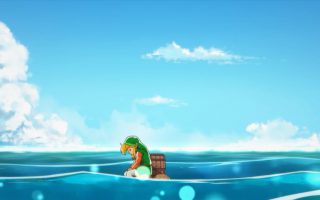 The small item pool means that the variety of puzzles you’ll encounter throughout the game are incredibly limited, and you’ll be spending a lot of time in menus to swap one item for a single-use than replacing it again. The game feels overly tedious and drawn out because it doesn’t clearly communicate anything to the player. All the magic seems to have left Link’s Awakening as it’s aged, but luckily for you, there are other great Zelda games on the switch. Cadence of Hyrule is a fantastic rhythm game made by the team behind Crypt of the Necrodancer, while A Link To The Past (an all-time classic in the series) is available to Nintendo Switch Online subscribers. Both those games are far more entertaining and worth your time than Link’s Awakening.
The small item pool means that the variety of puzzles you’ll encounter throughout the game are incredibly limited, and you’ll be spending a lot of time in menus to swap one item for a single-use than replacing it again. The game feels overly tedious and drawn out because it doesn’t clearly communicate anything to the player. All the magic seems to have left Link’s Awakening as it’s aged, but luckily for you, there are other great Zelda games on the switch. Cadence of Hyrule is a fantastic rhythm game made by the team behind Crypt of the Necrodancer, while A Link To The Past (an all-time classic in the series) is available to Nintendo Switch Online subscribers. Both those games are far more entertaining and worth your time than Link’s Awakening.
Pros
- Pleasant art style
- Jumping adds a new dimension to combat
Cons
- Link’s design is off-putting
- Forgettable dungeon design
- The critical path is often unclear
- Limited item pool
- Only a slight variation in puzzles throughout the game.
